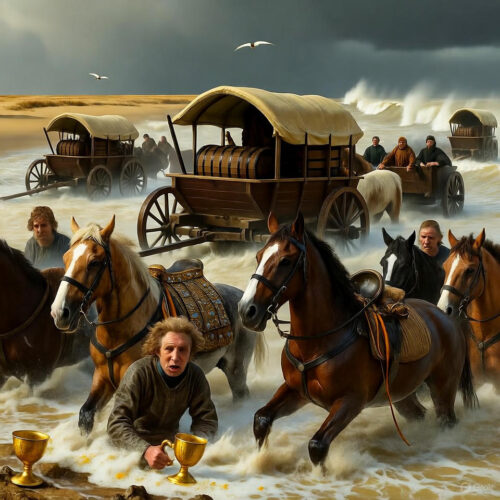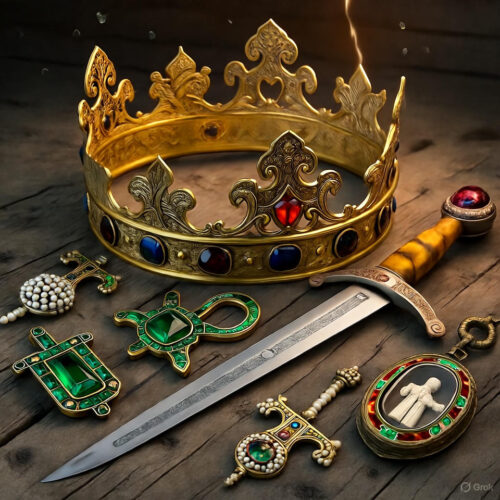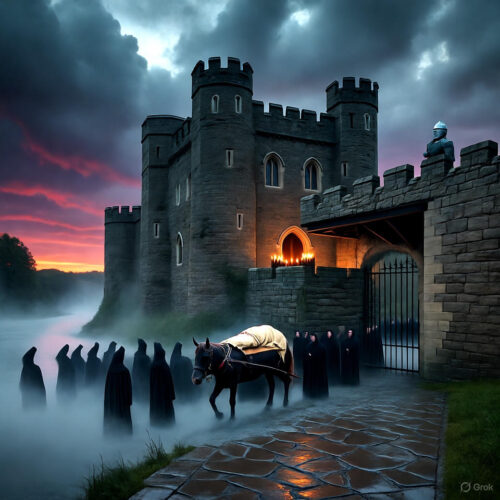Imagine a king, his body wracked by fever, his mind a storm of paranoia and desperation, leading a ragged army through the misty fens of medieval England. The year is 1216, and the realm is tearing itself apart in civil war. This king—John, the much-maligned brother of the legendary Richard the Lionheart—carries not just the weight of a crown, but wagons groaning under the burden of gold, gems, and ancient regalia that symbolize eight centuries of royal might. On October 12, as his baggage train fords a treacherous estuary known as The Wash, the tide turns not just literal but fateful. In a roar of swirling mud and saltwater, the sea claims everything: jewels that glittered in the courts of emperors, swords forged for conquest, chalices that held the blood of saints. No survivors emerge to whisper the news; the ocean keeps its secret. Nine days later, the king himself is gone, dead of dysentery and despair, leaving a nine-year-old boy to salvage a shattered throne.
This is no mere footnote in history’s ledger—it’s a pivot point, a moment where hubris met humility in the form of nature’s indifference. On this very date, 809 years ago, the loss of King John’s treasures marked the end of an era of unchecked tyranny and the improbable dawn of a more stable England under his son, Henry III. But beyond the drama, this tale whispers timeless truths: how clinging to material symbols of power can drag us under, and how their sudden absence can force reinvention. In the pages ahead, we’ll plunge into the gritty details of John’s doomed reign—the betrayals, battles, and bureaucratic blunders that led to that fateful crossing. We’ll unearth the shimmering specifics of what vanished into the waves, from emerald-studded clasps to the fabled crown of an empress. And then, with the salt still drying on our sleeves, we’ll turn that ancient catastrophe into fuel for today: practical, punchy ways to shed your own “crown jewels” of baggage and chart a lighter path forward. Buckle up—this is history at its most harrowing, hilarious in its human folly, and profoundly motivational in its redemption.
## The Shadow of the Lionheart: John’s Rocky Road to the Throne
To grasp the catastrophe of October 12, 1216, we must first wade through the muck of John Lackland’s early years—a nickname that stuck like mud on boots, bestowed by his father, Henry II, who saw little land to bequeath his youngest son among the Angevin Empire’s sprawling domains. Born in 1166 at Beaumont Palace in Oxford, John was the fifth son in a dynasty that ruled from the Scottish borders to the Pyrenees. His siblings were titans: Richard, the crusading poet-warrior; Geoffrey, the Breton duke; even little Eleanor, married off to the King of Castile. John, by contrast, was the spare’s spare, trained in administration rather than arms, shuttled between minor lordships like Ireland and Gloucester.
When Richard ascended in 1189, John’s fortunes flipped like a coin in a dice game. While Richard gallivanted to the Holy Land, leaving England in the regency of chancellors like William Longchamp, John played the homefront rogue. He plotted against his brother’s ministers, seized castles like Tickhill and Nottingham, and even flirted with Philip II of France, Richard’s arch-nemesis. Chroniclers like Roger of Howden painted him as a schemer: “John, the king’s brother, who was left in England, began to work wickedness against the kingdom.” Captured and ransomed in 1194, Richard forgave his brother—barely—but the seed of suspicion was sown. Upon Richard’s death from a crossbow wound at Chalus Castle in 1199, John snatched the throne, disinheriting his nephew Arthur of Brittany in a move that ignited French ire.
John’s early reign crackled with promise. He crushed a Welsh uprising in 1211, marching through Snowdonia with an army that left scorched earth in its wake—villages burned, cattle slaughtered, chieftains like Llywelyn ap Iorwerth forced to sue for peace. In Ireland, he donned a bizarre beaver-skin cap to mock the native kings, extracting oaths of fealty and hefty tributes. But promise curdled into peril. John’s obsession with reclaiming Norman lands lost to Philip II drained the treasury. The 1204 fall of Rouen to the French was a gut punch; by 1205, Anjou, Maine, and Touraine followed, shrinking the Angevin Empire to a rump state. To fund counterattacks, John squeezed his barons with scutage fees—taxes in lieu of knight service—that ballooned from two marks per knight’s fee in 1198 to three in 1214. He pawned jewels to Flemish merchants, borrowed from Jewish lenders at usurious rates, and even melted down chalices from Westminster Abbey.
The Church became collateral damage. In 1207, John refused Pope Innocent III’s nominee for Archbishop of Canterbury, appointing his own crony, John de Gray. The pope responded with interdict in 1208—England’s churches closed, no sacraments save baptism and extreme unction—turning the island into a spiritual wasteland. John seized church lands, pocketing revenues estimated at £4,000 annually, but the ploy backfired. Excommunicated in 1209, he quipped to his barons, “If the pope excommunicates me, I’ll make myself pope!” Yet isolation bred desperation; by 1213, with Philip II’s invasion fleet massing at Flanders, John capitulated, surrendering England as a papal fief and paying 1,000 marks yearly homage.
These fiscal fiascos festered resentment. Barons grumbled over “evil customs” like the murdrum fine—fines for unsolved murders of Normans—and John’s habit of selling justice, heirs’ marriages, and wardships to the highest bidder. In 1214, the Bouvines disaster sealed John’s fate: his allied army, 7,000 strong under Otto IV, shattered by Philip’s cavalry charge, losing 70 knights and the imperial eagle standard. Back home, whispers of rebellion grew louder, setting the stage for the barons’ ultimatum.
## The Great Charter and the Barons’ Fury: From Runnymede to Civil Inferno
By spring 1215, England’s nobility had had enough. Led by Robert Fitzwalter, lord of Baynard’s Castle and self-styled “Marshal of the Army of God and Holy Church,” a coalition of 25 barons seized London on May 17, demanding reforms. John, ever the procrastinator, stalled at Windsor, then fled to the Tower. Negotiations dragged through June, with Archbishop Stephen Langton—freshly reconciled with John after the papal submission—mediating. On June 15, at the water meadow of Runnymede between Staines and Windsor, John affixed his seal to Magna Carta Libertatum, the “Great Charter of Liberties.”
This 63-clause document was a baronial wishlist disguised as royal concession. Clause 12 banned arbitrary scutage without “common counsel.” Clause 39 promised no freeman would be imprisoned or disseised “except by the lawful judgment of his peers or by the law of the land.” Clause 61, the infamous “security clause,” empowered 25 barons to seize John’s castles and goods if he reneged. It was no democratic manifesto—serfs got nothing, and Jews were targeted in Clause 11—but it enshrined habeas corpus precursors and due process, echoes of which ring in modern constitutions.
John signed with gritted teeth, viewing it as a tactical pause. Within weeks, he appealed to Innocent III, decrying it as “shameful and demeaning… forced upon us by violence.” The pope annulled the charter on August 24, branding the barons traitors. John, emboldened, raised mercenaries—Welsh spearmen, Flemish crossbowmen—totaling 1,000 knights at £60,000 cost. Skirmishes erupted: the barons repelled John’s assault on Rochester Castle in October 1215, where the king starved out the garrison after seven weeks, hanging the mercenaries’ Welsh porters as “thieves.” By December, the rebels controlled eastern England, from Colchester to Lincoln, and invited Prince Louis, son of Philip II, to claim the throne as grandson of Henry II.
Louis landed at Thanet on May 21, 1216, with 400 ships and 7,000 men, capturing Rochester and Winchester en route to London, where he was proclaimed king at St. Paul’s. John, holed up at Corfe Castle in Dorset, rallied in the west but faced collapse. Scottish King Alexander II invaded Northumberland, burning Carlisle. John’s response was a scorched-earth rampage through the rebel heartlands, targeting monasteries for plunder—Bury St. Edmunds Abbey lost £700 in plate. By September, he reached Cambridge, then swung north to relieve Lincoln Castle, besieged since May. Success there buoyed him briefly, but dysentery, caught in the fetid fens, gnawed at his guts.
## The Desperate Dash: From King’s Lynn to the Jaws of The Wash
Autumn 1216 found John a shadow of his scheming self—pale, purging, propped up by loyalists like William Brewer and Peter des Roches, Bishop of Winchester. From King’s Lynn, a bustling port on the Norfolk coast where he’d stockpiled wine, arms, and grain, he plotted a counteroffensive. News of Alexander II’s southward march from Berwick demanded haste; John resolved to intercept the Scots before they linked with Louis. On October 11, he dispatched his baggage train—a lumbering caravan of 20-odd wagons, ox-carts, and 50 packhorses—across The Wash to Spalding in Lincolnshire, aiming for a rendezvous.
The Wash, that 15-mile-wide maw between Norfolk and Lincolnshire, was no gentle bay but a tidal beast. Fed by the Nene, Ouse, Welland, and Witham rivers, its sands shifted like quicksilver, exposing causeways at low tide but unleashing bore tides—walls of water racing upstream at 10 miles per hour—on the flood. Medieval travelers knew its perils; the Anglo-Saxon Chronicle warns of “the devouring sea” that claimed unwary pilgrims. John’s route hugged the old Roman road from Lynn westward to Walpole Cross Keys, then south across four miles of flats toward Holbeach and the Wellstream ford (modern River Nene mouth). Guides, locals familiar with the sands, led the way, but timing was everything: high water at Lynn meant the tide would hit the crossing by noon.
The convoy was a king’s ransom on wheels. Wagons bore not just victuals—barrels of Gascon wine, salted pork, wheaten loaves—but the portable pomp of monarchy: silk pavilions embroidered with leopards, suits of Milanese plate armor, and the iron-bound coffers of treasure. Escorted by a rearguard of knights and archers, it snaked through reed-choked marshes under gray skies. John himself, riding ahead with his household knights, veered via Wisbech to skirt the danger, a decision born of caution or clairvoyance.
What happened next is pieced from chroniclers’ fragments, each adding color to the chaos. Ralph of Coggeshall, writing in the 1220s at Coggeshall Abbey, notes John fell ill in Lynn “from eating peaches and new cider,” but the baggage loss amplified his woes. The Histoire de Guillaume le Maréchal, that epic verse biography of the era’s greatest knight, alludes obliquely to the king’s dwindling resources: “He had little treasure left, nor much money.” But it’s Roger of Wendover’s Flores Historiarum that delivers the thunderclap: “About the 12th of October, as he was crossing the Wellstream with his army, the tide came in so impetuously upon them that they were all drowned except the king himself, who escaped with great difficulty on horseback. In this disaster he lost all his treasure, his carts, his chariots, his sumpter-horses, and almost all his domestic servants.”
The tide, that silent assassin, struck like a hammer. Low water exposed the sands around 10 a.m., but the flood bore from the Nene estuary surged unexpectedly, perhaps swollen by autumn rains or a neap tide miscalculation. Horses panicked, bogging in sucking mud; wagons tilted, spilling harnesses and helms. Whirlpools—those “bottomless pits” of Wendover—gripped axles, dragging loads under. Men drowned clutching saddlebags, their cries lost to the wind. No tally of dead survives, but estimates run to dozens: grooms, cooks, a few knights. The sea, insatiable, feasted on finery worth a baron’s ransom—perhaps £10,000 in modern terms, enough to hire 2,000 mercenaries for a year.
Word reached John that evening in Wisbech, perhaps via a lone swimmer or flotsam-spotted scout. His reaction? A binge of “peaches and sweet wine,” per Coggeshall, hastening the dysentery that would claim him. “He rolled and writhed in agony,” writes Matthew Paris in his Chronica Majora, “cursing the day he was born.” The loss wasn’t just pecuniary; it was personal. These weren’t cold coins but heirlooms: rings from popes, crosses from crusades, symbols of divine right now fodder for crabs.
## The Glittering Grave: Cataloging the Crown’s Vanished Vault
What precisely did the Wash devour? Medieval inventories are sparse—kings hoarded secrets like squirrels nuts—but piecing together John’s 1215 treasury haul from prelates and Templar vaults paints a dazzling portrait. In June that year, desperate for war funds, John summoned bishops and abbots to Westminster, commandeering their plate. Bishop Guy of Carlisle tallied: 143 golden cups, 14 silver-gilt goblets chased with vines, 14 ewers for handwashing, 8 flagons etched with biblical scenes, 5 pairs of basins rimmed in niello. Belts numbered 40, clasps 6—brooches of fired gold pinning mantles. Staffs: 16 pastoral crooks for bishops, now royal pawns. Rings: 52, from sapphire solitaires to ruby signets; pendants: 2, enameled reliquaries dangling from chains.
Sacred splendor shone brighter. Four shrines—reliquaries of oak and ivory encasing saintly bones—two gold crosses inlaid with lapis, three combs of chased silver for anointing hair. A pearl-ornamented vessel, likely a ewer from Holy Roman Emperor Otto IV’s gift; twin candelabra branching like menorahs; thuribles swinging incense; phylacteries—golden prayer boxes—for monastic use. From Norwich came a clasp “wondrously wrought with emeralds and rubies,” a thumb-sized brooch that could ransom a knight. Pope Innocent’s 1204 largesse: four rings, one a massive sapphire said to ward off poison, another engraved with the Fisherman’s seal.
Regalia crowned the cache—literally. John held two sets: the “great” for coronations, the “lesser” for travel. The latter, inherited from Empress Matilda (his grandmother, Henry I’s daughter), included her German crown: a hoop of gold filigree, arched with fleurs-de-lis, set with table-cut garnets and cabochon sapphires from Saxony mines. Weighing near a pound, it evoked Matilda’s 1141 claim to the throne, her “she-wolf” defiance against Stephen. Swords: two, one the ceremonial “Sword of Tristram,” blade etched with Arthurian runes, hilt jeweled in amber and jet; the other, a battle-ready falchion from Toledo, pommel a snarling lion. A royal pallium—purple silk mantle embroidered with golden leopards, edged in ermine—completed the kit, folded atop coffers of bezants (gold coins) and silver pennies minted at John’s behest.
Not all vanished; some melted for coin, others stashed at Corfe for young Henry. But the travel set? Gone. Matthew Paris laments: “Things which the king loved beyond life itself.” Their loss crippled symbolism more than solvency—John’s mercenaries mutinied anyway, but the void haunted successors. When Henry III crowned in 1220 with St. Edward’s Crown (the Confessor’s relic, spared the tide), whispers lingered: was Matilda’s circlet forever silt-bound?
## Dysentery’s Dagger: From Tidal Grief to a Throne in Mourning
The Wash’s theft broke John not just in purse but in spirit. Retreating to Sleaford, then Newark Castle on the Trent, he worsened—abdomen swollen, stools bloody, fever raging. Loyalists like the Earl of Salisbury urged rest, but John raved of plots, demanding his son’s safeguarding. On October 18, confessing to a priest, he named regents: William Marshal for military, Hubert de Burgh for treasury, Peter des Roches for counsel. At dawn October 19, aged 48, he expired, body “swollen like a toad,” per Paris—likely septic shock from untreated infection.
Rumors swirled: poisoned by a monk? A surfeit of lampreys? No—the mundane gut bug of medieval marches. John’s entrails, per his will, went to Worcester Cathedral; heart to Northampton; corpse to Beaulieu Abbey, his Cistercian foundation in Hampshire, founded 1204 as penance for Arthur’s murder (whispers said). Funeral cortege snaked south, dodging rebel ambushes, interred October 23 amid chants of *Libera me, Domine*.
Henry, nine, fled to Devizes, then Gloucester. On October 28, in the cathedral’s shadowed nave, Guala Bicchieri—papal legate—crowned him with a makeshift “golden fillet,” no full regalia in sight. Witnesses noted the boy’s terror, clutching a scepter improvised from ivory. The loss loomed: without jewels, the ceremony skimped, but papal bulls excommunicated Louis, swaying waverers. Marshal’s genius turned tide—naval victory at Dover in May 1217, slaughter at Lincoln’s siege in the same month. Louis slunk home via Treaty of Lambeth, September 1217, renouncing claims for 10,000 marks.
John’s fall birthed renewal. Magna Carta reissued in 1216 (sans security clause), then 1217 with Forest Charter addendum, curbing royal hunts. Henry’s minority, under Marshal till 1219, stabilized finances—jewels or no, the realm endured. Yet the Wash’s ghost lingered: no new crown minted till Edward I’s 1307 gem-studded band, perhaps echoing Matilda’s lost glory.
## Quests in the Quagmire: Eight Centuries of Muddy Hunts
The allure of silted gold has lured diggers since. In 1906, archaeologist W.H. St. John Hope mapped the crossing: Lynn to Walpole, then sands to Holbeach, tide hitting at 2 p.m. But 1913 surveys by hydrographer F.H. Skues debunked—Nene’s old mouth shifted south, marshes drained by 17th-century Dutch engineers like Cornelius Vermuyden. 1972’s resistivity probe by G.F. Tagg traced a three-mile path near Guy’s Head, yielding Roman potsherds but no royals.
Amateurs fared little better. 2016’s Tydd St. Giles dig unearthed buckles, nails—baggage leavings?—but no sparkle. March 2024’s Walpole Marsh excavation, ahead of solar panels, sifted 10,000 artifacts: medieval horse fittings, a silver penny of John himself. Led by the West Norfolk Archaeological Unit, it tantalized with “anomalies” in magnetometry scans—sunken wagons?—but silt prevailed. Local legend-monger Colin Seeley, a tractor driver turned detectorist, claimed 2022 finds near Sutton Bridge: harness bosses, a gilt spur—prompting headlines, then shrugs from experts.
Why persist? Value: a single ruby clasp could fetch millions. Symbolism: unearthing John’s hoard rewrites villainy as victimhood. As History Today’s Ivan Mortimer notes, “The Wash devours secrets as greedily as gold.” Modern tech—ground-penetrating radar, LiDAR—may yet pry them loose, but for now, the sea mocks our metal-detectors.
## From Royal Ruin to Personal Rebirth: Lessons the Tide Teaches Today
John’s saga, for all its medieval mayhem, isn’t dusty relic—it’s a mirror to our own cluttered quests. The Wash didn’t just swallow gold; it stripped a king bare, forcing his line to rebuild without baubles. The outcome? A leaner, wiser realm, where power stemmed from pacts, not plate. Today, that same stripping—losing what we clutch too tightly—can propel us forward. Material anchors, like John’s jewels, weigh us down in stress and status-chasing. Their absence? Liberation. Here’s how to harness this 1216 upheaval in your life, with laser-specific bullets turning historical havoc into daily dynamite. More history than pep talk, remember—but oh, the motivation in seeing John’s folly as your freedom.
– **Audit Your “Crown Jewels” Weekly**: John inventoried his treasures obsessively, yet lost them to haste. Start Sundays: list 10 possessions you “love beyond life” (phone? Wardrobe? Gadgets?). Rate each 1-10 on joy vs. burden—does that designer bag spark delight or debt? Donate or sell three low-scorers monthly. Benefit: Frees mental bandwidth; studies show decluttering cuts cortisol 20%, echoing how Henry’s regents thrived post-loss, focusing on alliances over artifacts.
– **Map Your Personal “Wash” Crossings**: The estuary’s treachery came from ignoring tides—John’s guides misread the flood. Chart your “tides”: track calendar peaks (deadlines, social drains) via app like Google Calendar. Before big moves (job switch? Move?), scout “low tides”—ally input, rest days. Specific: Block 30-minute “tide checks” Tuesdays; adjust routes like John should have via Wisbech. Gain: Dodges drownings in overcommitment; John’s detour saved him temporarily—yours builds resilience, turning potential pitfalls into pivots.
– **Binge on “Peaches” Mindfully, Not Desperately**: Grief drove John to gluttony, hastening death. When loss hits (layoff, breakup), ritualize release: stock “peach equivalents”—dark chocolate, herbal tea—for 15-minute “grief feasts” post-setback. Journal three gratitudes mid-bite, channeling chronicler Paris’s empathy. Perk: Transmutes despair to digestion; research links mindful indulgence to 15% mood lifts, mirroring how John’s demise cleared space for Marshal’s victories.
– **Forge “Magna Cartas” with Your Inner Barons**: John’s charter curbed tyranny; post-Wash, it endured sans jewels. Recruit three “barons”—trusted friends—for quarterly “charters”: co-write rules like “No work emails post-8 p.m.” Enforce with playful penalties (loser buys coffee). Upshot: Builds boundaries; like 1217’s reissue, it stabilizes life, reducing burnout by fostering accountability amid chaos.
– **Hunt Your Own “Lost Treasures” Annually**: Modern searches for John’s hoard thrill with possibility. Dedicate New Year’s Day to a “silt-dive”: review past year’s “sunken” goals (unread books? Faded hobbies?). Unearth one—read that novel in 20 pages/day bursts. Reward: Rekindles purpose; as 2024 digs tease artifacts, this revives your “gems,” boosting fulfillment akin to Henry’s 1220 full coronation pomp.
### Your 30-Day Tide-Taming Plan: From John’s Loss to Your Launch
Ready to let the sea take what drags? This step-by-step blueprint, inspired by the 1216 pivot, spans a month—phased like John’s march, but yours ends in elevation, not entombment.
**Week 1: Recon the Realm (Prep Like Pre-War John)**
– Day 1-2: Inventory life “jewels”—physical (closet purge), digital (app deletions), emotional (toxic ties list).
– Day 3-4: Map “Washes”—identify three risk zones (e.g., overwork flood). Consult a “guide” (mentor chat).
– Day 5-7: Sign your “Magna Carta”—draft personal rules, share with one ally. Celebrate with a symbolic “peach” (favorite treat, guilt-free).
**Week 2: Cross with Caution (The March North)**
– Day 8-10: Declutter drive—tackle one zone daily (e.g., Day 8: desk). Bag donations; feel the lightness.
– Day 11-12: Tide drills—practice detours: swap a draining habit (scrolling) for energizing (walk). Log wins.
– Day 13-14: Grief buffer—face a mini-loss (skip a non-essential event); journal, feast mindfully.
**Week 3: Embrace the Engulfing (The Loss Itself)**
– Day 15-17: “Let go” ritual—burn (safely) or bury a symbolic item (old journal page). Meditate on John’s escape: what survives you?
– Day 18-19: Baron council—meet your trio; refine charter, enforce one rule.
– Day 20-21: Hunt mode—resurrect a “sunken” passion (e.g., guitar lesson via app).
**Week 4: Rise from the Reeds (Henry’s Dawn)**
– Day 22-24: Momentum build—tackle a “siege” (big goal, like resume update) with regent support (accountability buddy).
– Day 25-26: Coronation mock—affirm progress in mirror: “I rule sans baubles.” Reward with outing.
– Day 27-30: Legacy lock—plan next quarter’s “treaty” (goals sans excess). Reflect: How lighter are you?
By month’s end, you’ll have shed John’s weight, emerging like Henry: unadorned but unbreakable. The Wash took treasures but birthed balance—your turn to trade trinkets for triumph.
In the end, October 12, 1216, wasn’t defeat—it was deposition of the superfluous. John’s jewels rust in legend, but their lesson gleams: true sovereignty lies not in what you hoard, but in what you release. Dive in, dear reader; the tide waits for no one, but it might just float you free.

